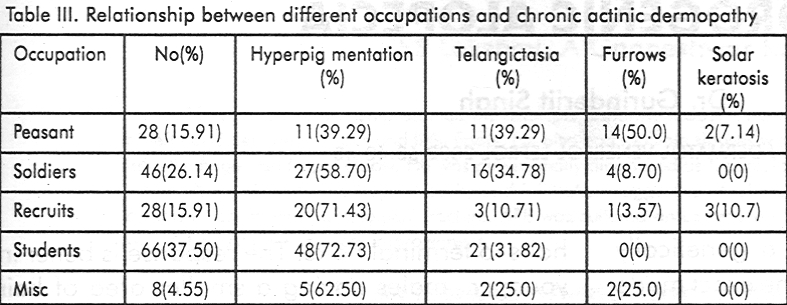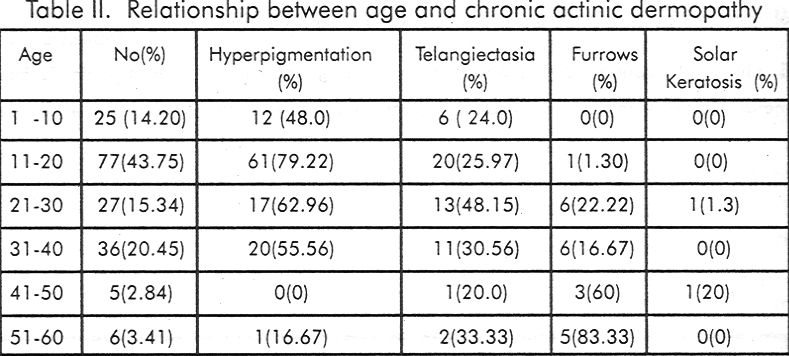Translate this page into:
Chronic actinic dermopathy - A clinical study in Ladakh
Correspondence Address:
M PS Sawhney
Department of Dermatology and STD Command Hospital (SC), Pune - 411 040
India
| How to cite this article: Sawhney M P. Chronic actinic dermopathy - A clinical study in Ladakh. Indian J Dermatol Venereol Leprol 2002;68:38-39 |
Abstract
A total of 176 highlander Ladakhis staying at Leh (Ladakh) at an altitude of 3445 meters were examined for skin changes on the exposed parts of the body. 111 (63.07%) had pigmentation over forehead, cheeks, nose or chin, 53 (30.11%) had telangiectasia over nose, cheeks or ear lobules, 21 (11.93%) had thickening and furrowing over forehead or lateral aspect of the eyes and only 5 (2.82%) had solar keratosis. Pigmentation and telangiectasia though seen in the first decade of life with prevalence rate seen as 48% and 24% respectively, the maximum prevalence has been seen in the second and third decade (79.22% and 25.97% and 62.96% and 48.15% respectively). Thickening and furrowing is seen most commonly in the fifth and sixth decade, which also leads to decreased prevalence of pigmentation and telangiectasia. Telangiectasia as a skin change to prolonged exposure to short wave length UV radiation has not been described by Eguren in 1972. Dilatation of the blood vessels in the dermis described by him correlates well with our finding of telangiectasia. Thus skin changes of pigmentation, telangiectasia, thickening and furrowing of the sun exposed skin and histopathological changes of Egurer s HA Dermopathy should be included in the syndrome of chronic actinic dermopathy.





Introduction
The native highlanders are exposed to prolonged high doses of ultraviolet radiation especially those who work outdoors. They have been reported to develop pigmentation, thickening and furrowing of the skin.[1] Histopathological entity with specific changes in epidermis and dermis called high altitude dermopathy has been described earlier by Eguren.[2] This prompted us to undertake a study of skin changes in highlander Ladakhis staying at an altitude of 3445 meters at Leh (Ladakh).
Materials and Methods
Atotal of 176 highlander Ladakhis were examined for skin changes on the exposed parts of the body.
Results
The mean age of the subjects was 22.28 years (range 3 - 58 years). 125 (71.02%) were males and 51 (28.98%) were females.
A total of 111(63. 07%) of patients had hyperpigmentation over forehead, nose, cheek or chin. Telangiectasia over cheeks, ear lobules or nose was seen in 53 (30.11%). 21(11.93%) had thickening and furrowing over forehead and lateral aspects of eyes. Solar keratosis was seen in only 5(2.82%) of the subjects. Relationship between sex and chronic actinic dermopathy is as shown in [Table - 1].
Relationship between age and these changes is an shown in [Table - 2].
The subjects belonged to various occupations and the relationship between the occupations and these changes is as shown in [Table - 3]. In the miscellaneous group two of them were preschool children, 3 were housewives not involved in farming,one each were clerk, teacher and shopkeeper.
Discussion
Native highlanders especially peasants engaged for long hours in the field exposed to ultraviolet radiation of shorter wave lengths have been described to develop pigmentation, thickening and furrowing of the skin.[1] Apart from this we also found a high incidence of telangiectasia over the cheeks, nose or ear lobules in highlander Ladakhis. The values of UVB radiation at Leh have been found to be 250% of those found at the sea level at mid noon.[3]
The clinical changes of chronic actinic dermopathy should thus include hyperpigmentation, telangiectasia, thickening and furrowing of the skin exposed to prolonged ultraviolet radiation as is present in high altitude areas. Histopathologically it produces changes as has been described by Eguren as high altitude dermopathy.[2] The presence of dilated blood vessels and lymphatics as described by him correlates well with our finding of telangiectasia. The prevalence of solar keratosis in Ladakhis has been found to be low as compared to some of the Western reports in individuals with fairer complexion.[1],[4] We did not come across any case of skin malignancy.
The skin changes of chronic actinic dermopathy start right in the childhood. Due to chronic sunburn reactions high incidence of hyperpigmentation (48%) and telangiectasia (24%) has been seen even in the first decade in this study. These changes continue to incise during second, third and fourth decades of life. The incidence of telangiectasia reaches its peek in the third decade. Then due to thickening and furrowing of the skin most commonly seen in the fifth and sixth decades incidence of telangiectasia and hyperpigmentation decreases. These changes thus represent the process of acclimatisation of the skin to high doses of short wavelength ultraviolet radiation.
Telangiectasia, thickening and furrowing of the skin have been found to be slightly more common in females. High incidence of hyperpigmentation over face found in students and recruits is because this group is in the first and second decades of life and being exposed to long hours of outdoor playing or training activities. Thickening and furrowing of the skin is more common in peasants.
| 1. |
Heath D, Williams DR. Skin and nails, In High Altitude Medicine and Pathology. 4'h edition, Oxford, New York, 1995: 307 - 316.
[Google Scholar]
|
| 2. |
Eguren VI. Morfologia histologica de le pie[ expuesta en grades altitudes. Dermatopatio de alture. Unpublished M.D. thesis Universidad National Mayor de San Marcos, Lima, 1972 (as quoted in 1. above).
[Google Scholar]
|
| 3. |
Basu CK, Goutam RK, Kumar H, et al. Comparative evaluation of biochemical problems at equivalent high altitude areas in the Eastern and Western Himalayas. Project Report No. DIP AS/29/96, Delhi, 1996: 54 - 63.
[Google Scholar]
|
| 4. |
Sanderson KV, Mackie R. Tumours of the Skin, In Textbook of Dermatology, edited by Rook A, Wilkinson DS, Ebling FJG, 3rd edition, Blackwell Scientific Publications, Oxford, 1979, 2129 - 2231.
[Google Scholar]
|





